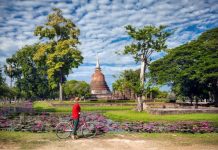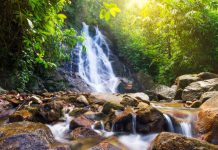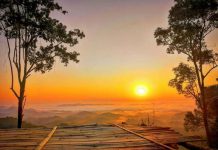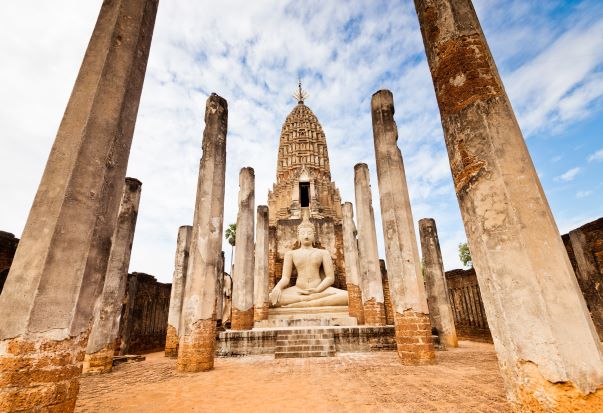
Sukhothai, a world heritage site which its long history since King Ramkhamhaeng the Great. And any tourist who especially the fan of ancient remains must not miss visiting the exotic and artistic temple “Wat Phra Si Rattana Mahathat” that lasts more than 8 centuries in this world heritage city.
At a Glance
Wat Phra Borommathat Chalieng or the official name is Wat Phra Si Rattana Mahathat Ratchawaraviharn which means “Temple of the Great Relic” or also called Wat Phra Prang is a part of the famous Sri Satchanalai History Park. The site locates 3 km outer the city wall to the southeast. The historic city was a city called Chalieng and changed to Sri Satchanalai during the Sukhothai’s Phra Ruang dynasty. There is the discovery of 134 archaeological sites currently for examples are Wat Nang Phaya, Wat Chedi Thaew, and Wat Chang Lom, and all of them already restored appropriately.
Wat Phra Borommathat Chalieng is a large monastery compound of the ancient Sukhothai. It is an insignificant historical site that is plenty of the important and the most amount in ancient remains in Sukhothai. The total number of the pagoda within the location is 200 included the most remarkable iconic structure of the temple which is the Main Phra Prang, a sizeable squared shape foundation pagoda made from laterite. The prang has staircases at the front that ascends to the archway to enter the prang. There is a small prang inside there to housed the Buddha’s relic.
Wat Phra Si Rattana Mahathat registered as the National Historic Site in 1932, and later it is transferred to be under the administration of Sangha Supreme Council of Thailand in 1936. And in 1958 the monastery was upgraded to be the first class royal temple at last.
Background of the Temple
There’s no any evidence of the establishment of the temple, however, from the study in archaeology assumed that the temple found since the glorious of Khmer or around 800 years ago at least. Anyhow, according to location may track back further than that since it was the centre of the old city Chalieng that was the same period of Dvaravati.
The assumption that the temple was the centre of the ancient city Chalieng around the 18th BE when the Thai culture was dominated strongly by Khmer. The undeniable proof is the archway of the stupa which is the laterite furnished with the concrete of human face and dancing Apsara that is similar to the Khmer’s Bayon art.
Then, in Sukhothai period, the temple was still the most sacred religious site that is claimed by its numbers masterpiece of art such as the Walking Buddha statue housed in the main viharn (the royal chapel) and the mondop (Square hall) of Phra Atthasara. Later in Thonburi era, when King Taksin marched to subdue Phra Fang of Sawangkhaburi, and he also took an occasion to worship Phra Borommathat of Chalieng as well. Furthermore, Wat Phra Si Rattana Mahathat was the venue of Royal ceremonial bath of purification since the ancient time.
The Ancient Remains within the complex
Wat Phra Si Rattana Mahathat Ratchawaraviharn contains a large group of archaeological remains by following;
1. The Main Prang
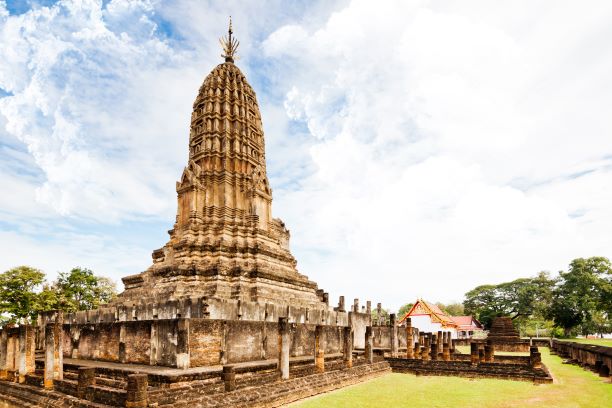
The principal lotus-bud top pagoda, which is the unique character of the pure Sukhothai architectural art, is right in the middle and surrounded by the satellite prangs in all corners that shows the influence of Khmer. The eight satellite stupas, of which the four at the corners are in Lanna style, and the four in between are Sukhothai decorated with the fresco which influenced by Ceylonese. Its base is embellished with 168 stuccoed image of Buddhist prataksina (clockwise) walking with their hands clasped together in salutation.
The central principal stupa is made from laterite and red coated after white-wash. The pagoda houses a small lotus-bud stupa which stored the most sacred object that called “the Buddha’s Relic”. From the remaining evidence on the interior wall shows that it used to be the mural painting in red, whereas there are staircases in front of the stupa.
The appearance of the pagoda is 3-layer sinuous structure with solid wall and clerestory. The base of the pagoda extended further in 3 ways (the royal chapel is at the front) features the structure was created to cover the insignificant stupa inside. The pagoda claimed to be during the early of Sukhothai since there found the ruin which made of brick is below the foundation of the royal chapel. Besides, there is eaves tile in Apsara and deity images which represents the Khmer’s Bayon style. As same as the archways in all four corners of the monastery wall, of which the fresco imaging Phra Avalokita Suan decorated on top, and the image of the angle sit inside the frame. The lower arched space garnished with the dancing Apsara. There is a giant Buddha enshrined in front of the pagoda, whereas the large subduing mara Buddha image housed in the centre with two small standing Buddha statues on both sides. Moreover, there is an aesthetic Buddha image in the attitude of walking on the right of the subduing Mara figure which is claimed that it is one of the most magnificent Buddha images in Sukhothai.
2. The Wall
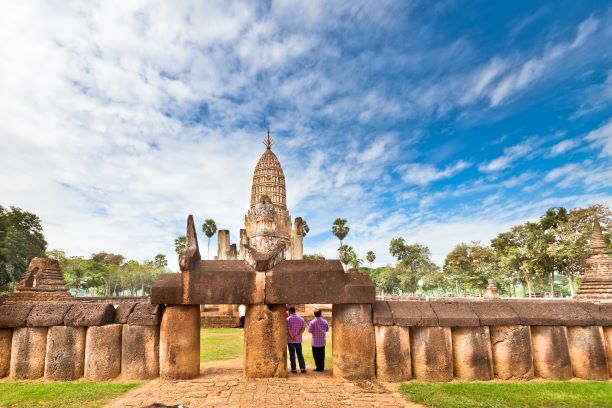
The monastery wall is the sizeable cylindered laterite pole pitched orderly into the rectangular shape which is 60 m wide and 90 m long. It has a counterpoise behind the wall with the gate, and above the archway is roof style. And there is the Phra Bhodi Satra Avalokita Suan figure on the top of the arch.
3. Mondop of Phra Attharot
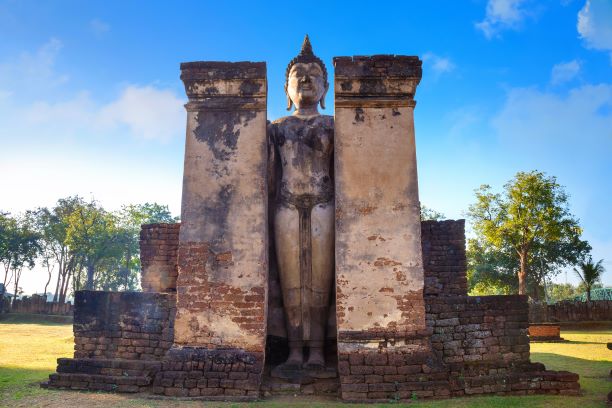
It stands on both sides of the principal chedi. The structure housed the massive standing post of Buddha image called Phra Attharot. The 9-meter tall Buddha image made followed to the belief of Ceylonese that is available in any other temples in Sukhothai. The original mondop (squared hall) of Phra Attharot assumed that housed a 4-post of Buddha image and then was modified. The standing Buddha statue still enshrined inside the arched space. And the structure used to be the ceramic roof initially.
4. Viharn Luang (the Royal Chapel)
Laterite large and high ceiling building locates in front of the principal pagoda, contains 11 chambers. And the backward of the building found the plaster pedestal of a Buddha image used to enshrine the giant bronze Buddha image named “Phra Sri Sakayamunee that was cast by King Mahathammaracha I in 1362. And the statue was invited to house in the royal chapel at Wat Suthat Devawararam, Bangkok during the reign of King Phutthayotfa Chulalok of Rattanakosin Kingdom.
5. Phra Viharn Soong (the High Chapel)
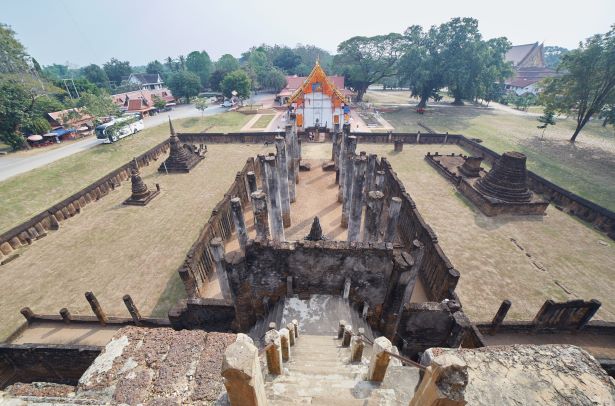
The building sites in front of the Royal Chapel. Phra Viharn Soong was established later in Ayutthaya style which made from brick and laterite pillar. Inside the building housed the Ayutthaya stuccowork of Buddha image as the primary sacred object.
6. Viharn Song Phi Nong (Brother Chapel)
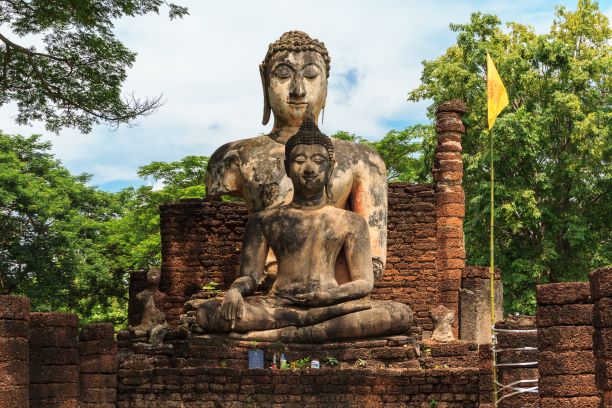
It locates in the left of Phra Attharot statue made from laterite. There are two stucco Buddha images in the attitude of subduing mara on the pedestal. According to the archaeological evidence found that the foundation of the structure built over an ancient remain which made from brick. And there is the base of the Buddha’s footprint on the right of the viharn as well.
The statues of Buddha are the delicate and exotic Sukhothai pieces of art. However, the villagers say that head of the young brother Buddha image or one at the front was taken by the Fine Arts Department and installed the replica back instead. Apart from that, the fingers of the statue were damaged by the thief in last several years.
7. Ubosot (the Ordination Hall)
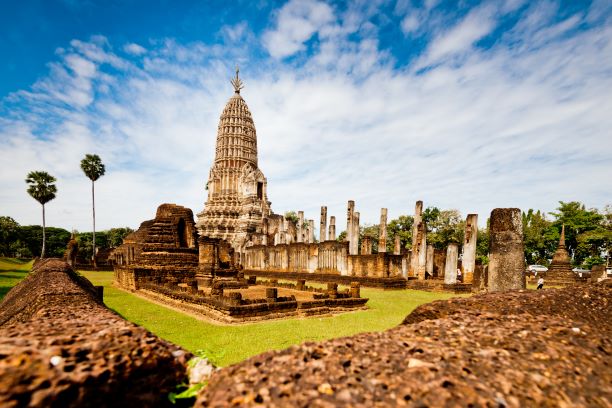
The hall locates next to the mondop to the north. It is brick-base structure and laterite pillar with the staircases on both sides. It is a house to enshrined a subduing mara Buddha image as a primary sacred image surrounded by slate Sema (boundary marker of a temple); also, there was a discovery of the gold inscription at this ordination hall too. Presently, the ubosot renovated rebuilt over the old structure; nonetheless, there is still the ruin of laterite foundation at the rear including the slate Sema. It assumed that the Semas were brought from the old Sukhothai because of its appearance that shares in common to the other locations found in general in the region. Moreover, Sri Satchanalai was not the location of slate like this. There are some photos show the ruins before reconstruction at that time – pillars, the rear wall, and the main Buddha image damaged. Fortunately, it was noticeable that the statue tends to Ayutthaya style and smaller than the primary model inside the Royal Chapel.
8. The five-topped Chedi
The chedi locates near the mondop to the south. It is a brick stupa and housed the Buddha images in the attitude of subduing mara in all 3 corners. At the foundation embellished with the stucco figures of demon, elephant, and deity. It believed that it is the house to store the relic of king Mahathammaracha (Lithai).
Other interesting archaeological structures and objects within the monastery
- Yod Noppasun Kalai Thongkham (the gilded plated nine tops pagoda).
- Wooden craved starred ceiling work of Sukhothai artisan. (It presently stores at the Ramkhamhaeng National Museum, Sukhothai).
- Craved gate work of Sukhothai artisan. (It presently stores at the Ramkhamhaeng National Museum, Sukhothai).
- Mystery hole to access down below of the Phra Prang.
- Luang Pho To, a giant Buddha image in subduing Mara attitude with 4.08 meters wide of the lap.
- A traditional Sukhothai stuccowork of walking Buddha statue.
- A stuccowork Buddha image in the attitude of standing.
- The loophole wall of the Royal Chapel which is the Sukhothai architectural art.
- Phra Ruang and Phra Leu arch.
- Defensive wall.
- The Brahma’ faces archway.
- The candle pillars around the main pagoda.
- Topless pagoda.
- The base of Dhammachakra Buddha chapel.
Taking the tour at Wat Phra Si Rattana Mahathat
Wat Phra Si Rattana Mahathat is a huge monastery complex with its delicate and exquisite art which well blends of Khmer and early Sukhothai. The laterite wall around the compound that is high and thick being a pleasant facade. And outside of the temple is also surrounded by the laterite wall which lines along the river Yom.
The famous King Jayavarman VII of Khmer kingdom respects the Buddhist Mahayana sect, and this temple was established during his reign. The most outstanding characters of Khmer art of which Bayon style roof and laterite foundation. The tourist can access to the temple from the eastern gate where is the location to enshrine the stucco figure of Phra Ruang and Phra Lue, the leaders of Tai who expelled the Khmer out of this region and found Sukhothai and Sri Satchanalai after then.
At the entrance, there is the image of 4-faces Brahma which represents to the Bayon art (late 12th century to the early of the 13th century) we can see at Angor Wat. Moreover, this style of architectural art can recognise from nowhere in Thailand but here only. Lower from that is the dancing Apsara and the Naga figure embellished on the laterite pillar. And there is a Buddha image in the attitude of Spreading Naga in a little shrine on the right when walking into the monastery complex.
Taking a tour in the complex, it is recommended for the visitors to see the beautiful art and architecture of the temple – (1) Viharn Luang Pho To (the Giant Buddha Chapel) (2) The Walking Buddha Statue (3) The Main Phra Prang. (4) The Buddha image in the attitude of meditation (5) Phra That Mutao the Mon style octagon laterite stupa (6) Mondop Phra Attarot (the Squared Hall) where housed Phra Attarot Buddha statue, and (7) Phra Viharn Song Phi Nong.
The Information of the monastery complex
- The site opens daily between 8.00am – 5.00pm
- Admission fee is: Thai is THB20 / Foreigner is THB100
- In case the visitor brings in the vehicle in the area of the historic park, there is a surcharge for that.
- The park provides the trolley tour service with the price is THB10 for Thai and THB40 for Foreigner.
- For inquiry of guided tour, the visitor can contact the Sri Satchanalai Historical Park office, Sukhothai call +66 5567 9211.
How to Get There
Sukhothai is about 550 km distance from Bangkok to the north.
From Bangkok
1. By Car :
Travel from Bangkok, there are 2 routes are:
- From highway number 1 drives pass Nakhon Sawan, Kamphaengphet. And enter the road number 101 passes Pran Kratai and Kirimas district to reach Sukhothai. The distance in total is 440 km.
- From highway number 1 heads toward until arriving at 50th km at Bang Pa-in junction, Phra Nakhon Sri Ayutthaya. Then, enters to the highway number 32 and heads toward to Nakhon Sawan. And comes to road number 117 to head to Phitsanulok. Then, take the road number 12 to enter to Sukhothai. The total distance is 427 km.
2. By Train:
State Railway of Thailand provides the express train departs from Hua Lamphong Terminal in Bangkok to get off at Phitsanulok station daily. Then, gets the bus to go to Sukhothai about 59 km more. For more information please contact the hotline 1690 and +66 2223 7010, +66 2223 7020 or www.railway.co.th
3. By Public Bus:
Transportation Company Limited provides both regular bus and the air-conditioned bus that depart from the Northern Bus Terminal (Mo Chit) at Kamphaengphet 2 road daily. The duration time of the trip is about 7 hours. For more information call +66 2537 8055-6, +66 2936 2852-66 or www.transport.co.th
Besides, there are private operators which are Win Tour call +66 5561c1039 and Bangkok office call +66 2936 3753 and Phitsanulok Yarnyont call +66 5525 8647 and Bangkok office call +66 2936 2924-5.
4. By plane:
Thai Airways offers the flight from Bangkok to Phitsanulok daily, then gets the bus to Sukhothai about 118 km more. For more information call 1566, +66 2280 0060, +66 2628 2000, +66 2356 1111. Phitsanulok branch call +66 5524 2971-2 or www.thaiairways.com
Bangkok Airways provides a direct flight to Sukhothai daily. For more information call +66 2229 3456-63. Sukhothai branch call +66 5564 7225-6 or www.bangkokair.com
From Sukhothai
1. By Car:
- Uses the highway number 101 route Sukhothai – Swankhalok – Sri Satchanalai until arriving at the 18th – 19th km. Then, takes the left turn and cross the River Yom bridge. There is the right fork to enter to the historic park and drives more 1.5 km to the destination. The total distance is about 68 km.
2. By Bus:
- Takes the bus at Sukhothai Bus Terminal route Sukhothai – Utaradit or Sukhothai – Chiang Rai and gets off at the intersection to enter to the Sri Satchanalai Historical Park.

